Search the Special Collections and Archives Portal
Search Results
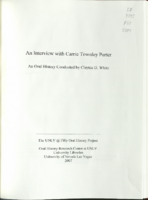
Transcript of interview with Carrie Townley Porter by Claytee D. White, February 7, 2006
Date
2006-02-07
Archival Collection
Description
Carrie Townley Porter, a 6th generation Texan, was born in Central Texas near present-day Fort Hood. Her father, a highway patrolman, was called into the Army Reserve in 1940 and spent some years moving around the country. At one point, his wife and children stayed in Belton, Texas tor three years because her father was transferred to places they couldn't go. Carrie finished high school in Austin, Texas, and attended two years at University of Texas in Austin. She left college to get married, and she and her geologist husband lived in Kansas, Oklahoma City, and Albuquerque. He took a job with the Atomic Energy Commission that required frequent trips to the Nevada Test Site, so the suggestion was made that they just move to Las Vegas. At this point they had three children with no reliable child care so Carrie became a housewife for a while. The Townleys lived a full and active life in Las Vegas and she eventually got hired as a substitute teacher. Carrie mostly subbed at Gibson Junior High School. She decided to finish her degree at Nevada Southern University (now UNLV) after her principal told her that if she could do that, he would have a job waiting for her. Several of the courses that Carrie took were Nevada history correspondence courses from UNR. These courses were prepared and graded by Dr. Russell Elliott. Carrie also fondly remembers two Nevada Southern history professors in particular, Dr. John Wright, whom she considered a mentor, and Rosemary Masick, who taught English history. After receiving her bachelor's, Carrie returned to teaching math at Gibson Jr. High. She started an archaeology club on her own and she and Russ Elliott started the first Trailblazer Club (junior history) in the state. She got students involved in the history of the Native Americans in the area and took them on field trips which gave them a chance to participate in a dig. Carrie has worked in Special Collections in the UNLV library as an archivist, with Sierra Pacific Power Company as a records analyst, and at Caesar's Tahoe as records administrator. She has also been very deeply involved with the Nevada Women's History Project since 1994. This group was responsible for the Sarah Winnemucca Statue Project, which placed a statue of this Native American in Washington, D.C., and a copy of it in the capitol building in Carson City. Today Carrie is doing a collaborative book on Helen J. Stewart with Sally Zanjani. She has done extensive research on Helen Stewart's life, and to this day makes "living history" presentations dressed as Helen J. Stewart. In addition to her history commitments, Carrie still holds onto her records management consulting firm, which she started in 1985.
Text
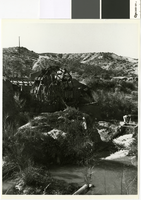
Photograph of waterwheel on the Muddy River near Logandale, Nevada, January 21, 1947
Date
1947-01-21
Archival Collection
Description
38 foot waterwheel on the Muddy River near Logandale, Nevada.
Transcribed Notes: Bureau of Reclamation typed notes appended to back of photo: Boulder Canyon Project, Nevada Region 3 A 38-foot water wheel lifts water 30 feet from the Muddy River to irrigate a farm near Glendale, Nevada.
Image
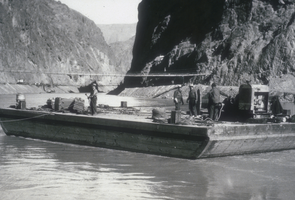
Slide of the barged used in construction phase of Hoover Dam, Colorado River, January 10, 1932
Date
1932-01-10
Archival Collection
Description
Black and white image of a barge used to transfer trucks and heavy materials across the Colorado River during the construction phase of the Boulder Canyon Project, better known as Hoover Dam. This specific barge is equipped with a double drum hoist. Note: Boulder Dam was officially renamed Hoover Dam in 1947.
Image
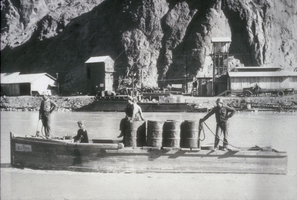
Slide of boats used in construction phase of Hoover Dam, January 10, 1932
Date
1932-01-10
Archival Collection
Description
Black and white image of boats used to transport men, powder, and supplies up and down the Colorado River in Black Canyon during the construction phase of the Boulder Canyon Project, better known as Hoover Dam. Note: Boulder Dam was officially renamed Hoover Dam in 1947.
Image
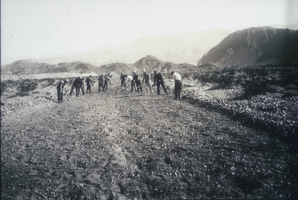
Slide of the construction phase of the Hoover Dam, November 19, 1931
Date
1931-11-19
Archival Collection
Description
Black and white image of the construction phase of the Boulder Dam Project, also known as Hoover Dam. This image features Six Companies, Inc. employees aligning and oiling six miles of road down toward the upper portals on Hemenway Wash.
Image
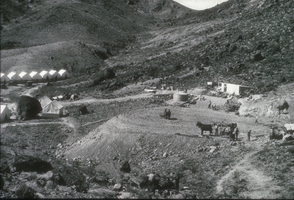
Slide of the construction phase of Hoover Dam, March 27, 1931
Date
1931-03-27
Archival Collection
Description
Black and white image of the construction phase of the Boulder Canyon Project, also known as Hoover Dam. Excavation for the Hoover Dam construction substation by the Nevada-California Power Company is visible. Note: Boulder Dam was officially renamed Hoover Dam in 1947.
Image
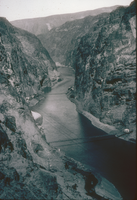
Slide of the Hoover Dam site at Black Canyon, October 12, 1931
Date
1931-10-12
Archival Collection
Description
Black and white image of the Hoover Dam construction site at Black Canyon showing an upstream view during construction. This picture is one of several that cover the entire construction phase of the Hoover Dam from beginning on October 12, 1931, to completion on September 11, 1936. Note: Boulder Dam was officially renamed Hoover Dam in 1947.
Image
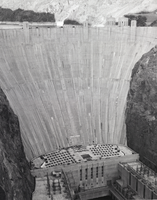
Photograph of the Hoover Dam powerhouse during a Young Presidents' Organization party, March 9, 1971
Date
1971-03-09
Archival Collection
Description
Black and white image of a celebration at the Hoover Dam powerhouse. The Young Presidents' Organization arranged a party for nearly 1,000 people that was held on the roof of the powerhouse. The visitors, the first to use this setting, would all be wearing hard hats. Tables, chairs, barbeque pits, a bandstand, and dance floor are visible.
Image
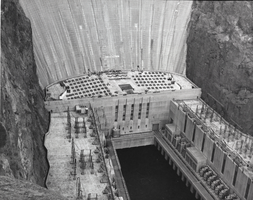
Photograph of the Hoover Dam powerhouse during a Young Presidents' Organization party, March 9, 1971
Date
1971-03-09
Archival Collection
Description
Black and white image of a celebration at the Hoover Dam powerhouse. The Young Presidents' Organization arranged a party for nearly 1,000 people that was held on the roof of the powerhouse. The visitors, the first to use this setting, would all be wearing hard hats. Tables, chairs, barbeque pits, a bandstand, and dance floor are visible.
Image
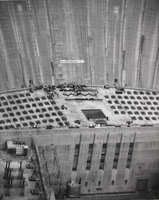
Photograph of a party held by the Young Presidents' Organization at Hoover Dam, March 9, 1971
Date
1971-03-09
Archival Collection
Description
Black and white image of a celebration at the Hoover Dam powerhouse. The Young Presidents' Organization arranged a party for nearly 1,000 people that was held on the roof of the powerhouse. The visitors, the first to use this setting, would all be wearing hard hats. Tables, chairs, barbeque pits, a bandstand, and dance floor are visible.
Image
Pagination
Refine my results
Content Type
Creator or Contributor
Subject
Archival Collection
Digital Project
Resource Type
Year
Material Type
Place
Language
Records Classification
